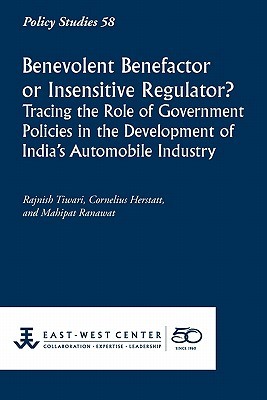
- We will send in 10–14 business days.
- Author: Rajnish Tiwari
- Publisher: East-West Center
- Year: 2011
- Pages: 64
- ISBN-10: 1932728902
- ISBN-13: 9781932728903
- Format: 15.6 x 23.4 x 0.4 cm, minkšti viršeliai
- Language: English
- SAVE -10% with code: EXTRA
Benevolent Benefactor or Insensitive Regulator? Tracing the Role of Government Policies in the Development of India's Automobile Industry (e-book) (used book) | bookbook.eu
Reviews
Description
The impressive and sustained growth of India's automobile industry in recent years has catapulted it into the league of the world's top-seven producers of four-wheelers. In the past decade, its exports have surged more than 25 percent a year on average. The turning point was arguably the 1991 policy of economic liberalization, but the impact of the reforms might have been subdued, if the Government of India had not played a pivotal role in the industry's evolution. This apparent "paradox" may be the key to understanding why the industry has adjusted so quickly to globalization, even though economic reforms began relatively late. This study identifies the main thrusts of policy regimes for the automobile sector since 1947, which began in an overregulation mode in the early period of independence. Nonetheless, the government consciously attempted to create and sustain favorable "innovation systems" at national, regional, and sectoral levels. Especially since 1991, many policy initiatives have benefited the industry and helped it reach the growth path it is following today.
- Author: Rajnish Tiwari
- Publisher: East-West Center
- Year: 2011
- Pages: 64
- ISBN-10: 1932728902
- ISBN-13: 9781932728903
- Format: 15.6 x 23.4 x 0.4 cm, minkšti viršeliai
- Language: English English
The impressive and sustained growth of India's automobile industry in recent years has catapulted it into the league of the world's top-seven producers of four-wheelers. In the past decade, its exports have surged more than 25 percent a year on average. The turning point was arguably the 1991 policy of economic liberalization, but the impact of the reforms might have been subdued, if the Government of India had not played a pivotal role in the industry's evolution. This apparent "paradox" may be the key to understanding why the industry has adjusted so quickly to globalization, even though economic reforms began relatively late. This study identifies the main thrusts of policy regimes for the automobile sector since 1947, which began in an overregulation mode in the early period of independence. Nonetheless, the government consciously attempted to create and sustain favorable "innovation systems" at national, regional, and sectoral levels. Especially since 1991, many policy initiatives have benefited the industry and helped it reach the growth path it is following today.


Reviews